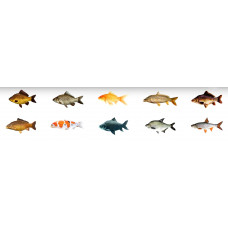Cyprinidae is a family of fishes of the order Cypriniformes. The body is naked or covered with scales. The mouth is toothless, retractable with pharyngeal teeth. There is a millstone. Includes more than 200 genera, of which the best known are roach, spruce, minnows, golyan, studs, white amur, bleak, shemai, bream, bream, line, gouster, chehoni, etc., and others. More than 1600 species. Inhabit freshwater and brackish water bodies of all continents, except Australia, South America and Antarctica. Small fish 20-40 cm long, only some species reach 1 m or more (white amur, fathead carp, carp, whiskers). Passable, semipassable and resident forms. Phytophagous, planktonophagous, benthosophagous, detritophagous and predatory. Spawning in the spring-summer period. Phytophagous, lithophilous, psammophilous, pelagophilous and ostracophilous species are distinguished according to the place of spawning.
The body is usually covered with scales, the head is bare, the edge of the upper jaw is formed by intermandibular bones, the abdomen is rounded, and if it has a sharp edge, then without ossification; fat fins are absent; the mouth is toothless, but the lower pharyngeal bones are well developed and have 1, 2 or 3 rows (often) of chewing teeth; grinding food with these teeth is facilitated by a thick horny plate at the expanded end of the outgrowth of the skull base. In some species at the corners of the mouth have short antennae that act as taste buds. The most numerous family of freshwater fish, only a few are found in brackish water (at the mouths of rivers, in the Black and Caspian Seas, etc.). The family includes 367 genera with 3006 species. Every year several dozens of new species are described, mostly from Southeast Asia.
Cyprinidae are distributed all over the Earth, except for most of South America (they are not found south of Mexico, but are ubiquitous in the Argentine pampa, where they were introduced in the second half of the XIX century, considered a weedy fish) and they were not in Australia (after introduction, carps became the most common fish in Australia). Most of them in the temperate zone of the Northern Hemisphere, feed on live and dead plant and animal food, many are very fertile, the males in the breeding season often develop a special "mating attire": they get a brighter color (most often appears pink), on the head, body and fins appear wart-like growths. In winter, they mostly hide on the bottom or burrow into the mud and go into hibernation. Some Cyprinidae are bred in ponds (carp, crucian carp), and quite a few serve as the subject of more or less significant fishing (roach, bream, carp, silver and golden crucian carp, tench, yazi, chekhon, etc.).
Most carps live in freshwater, but some species can tolerate salinities of 10-14°/00, and one species, the Far Eastern redfin, is found even at oceanic salinities (32-33°/00). But all of them lay eggs in fresh water. Species that live in brackish parts of the seas and go to spawn in rivers are called semi-passable. Some of them - roach, taran, bream, carp - enter the lower parts of rivers, while others - Aral mustache, cutthroat trout, redfish - make significant movements. In the latter case, the mating attire of spawning producers is more pronounced: bright coloration appears. Dwarf males are known in the Aral mustache; they do not leave the river and mature at a smaller size than the passage males.
Cyprinidae hatch a fairly large number of eggs. No live-bearing carps were found. Cyprinidae of temperate latitudes of the northern hemisphere lay eggs in the spring-summer period of the year. Females of some species lay eggs simultaneously, while others lay eggs at several times, in portions. As we move to lower latitudes, the percentage of batch spawning species increases and the spawning period becomes longer. Most carp species have bottom adhering eggs. Some species lay eggs on vegetation, others on rocks, others on sand; finally, there are species that lay eggs in the shells of bivalves. Some species have non-sticky eggs. They roll along the bottom or float in the water column.
Many Cyprinidae fish are targeted by recreational fishermen. Some Cyprinidae are objects of acclimatization and breeding (fathead minnows, amur, etc.). Small Cyprinidae are good bait for predatory fish.
Cyprinidae
Tags: cyprinidae


